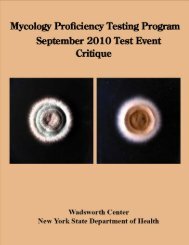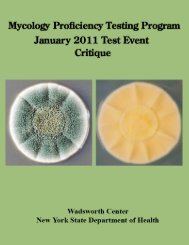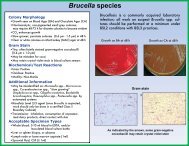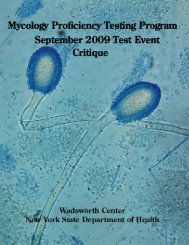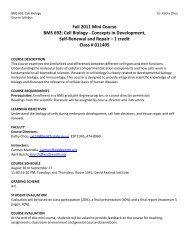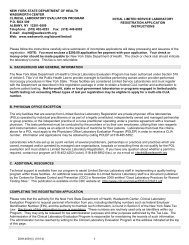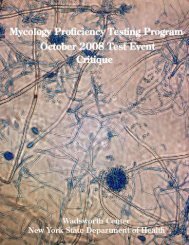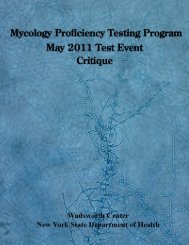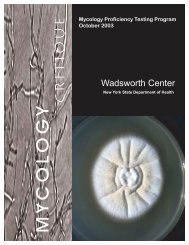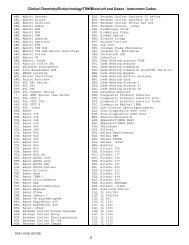September 2007 - Wadsworth Center
September 2007 - Wadsworth Center
September 2007 - Wadsworth Center
Create successful ePaper yourself
Turn your PDF publications into a flip-book with our unique Google optimized e-Paper software.
DIRECT DETECTION (CRYPTOCOCCUS NEOFORMANS ANTIGEN TEST)Introduction: A simple, sensitive latex test capable of detecting the capsular polysaccharide of C.neoformans in CSF and serum was described, and proven to be superior in sensitivity to the India ink mount(1, 2). Clinical studies established the prognostic value of the test (3, 5, 6 and 7), and showed it to be avaluable aid in establishing a diagnosis when culture was negative (4). Paired serum and CSF specimensallowed detection of antigen in confirmed cases (7). Parallel serologic studies for both antigen and antibodyare recommended to ensure detection of extrameningeal cryptococcosis. Newly emerging disease states andtherapies have been shown to increase the opportunity for nonspecific interference in some serum specimens.Pretreatment of serum specimens with pronase prior to utilization of the latex agglutination test reducesnonspecific interference, and enhances the detection of capsular polysaccharide antigens of Cryptococcusneoformans.Materials & Methods: Seventy-six laboratories participated in this event. Two positive serum samples forcryptococcal antigen were included in the <strong>September</strong> 26, <strong>2007</strong> direct detection antigen testing event. Oneserum was of low to medium titers (1:16), another one was of high titer (1:128). Titers within ± 2 dilutions ofthe reference results were the acceptable results. One positive (titer 1:128) educational serum sample fromanother batch of Cryptococcus antigen preparation was included in this event too.Results: The performance of 75 laboratories was satisfactory in this test event while 1 laboratory did notgive the response before the deadline. The supplementary information on qualitative and quantitative assayson Cryptococcus neoformans antigen test is summarized in Table 3 and 4.Comments: In last four test events, a number of laboratories obtained false positive results. These resultswere obtained with a particular test kit. In the current test event, none of the laboratories reported thisproblem possibly as a new batch of antigen was used among graded specimens. However, the previousproblem was reproduced in the educational specimen, which used an old batch of antigen.Further Reading:1. Bennett, J.E., Hasenclever, H.F., and Tynes, B.S. 1964. Detection of cryptococcal polysaccharide inserum and spinal fluid: value in diagnosis and prognosis. Trans. Assoc. Am. Physicians. 77: 145-150.2. Bloomfield, N., Gordon, M.A., and Elmendorf, D.F., Jr. 1963. Detection of Cryptococcus neoformansantigen in body fluids by latex particle agglutination. Proc. Soc. Exp. Bio. Med. 114: 64-67.3. Diamond, D. and Bennett, E. 1974. Prognostic factors in cryptococcal meningitis. Ann. Int. Med. 80;176-181.4. Goodman, J.S., Kaufman, L., and Koening, M.G. 1971. Diagnosis of cryptococcal meningitis: Value ofimmunologic detection of cryptococcal antigen. New Eng. J. Med. 285: 434-436.5. Gordon, M.A. and Vedder, D.K. 1966. Serologic tests in diagnosis and prognosis of cryptococcosis.JAMA. 197: 961-967.6. Kaufman, L. and Blumer, S. 1968. Value and interpretation of serological tests for the diagnosis ofcryptococcosis. Appl. Microbial. 16; 1907-1912.7. Kaufman, L. and Blumer. 1977. Cryptococcosis: The awakening giant. Proc. Of the 4 th InternationalConference on the Mycoses. Pan American Health Organication scientific publication #356. pp. 176-182.52



